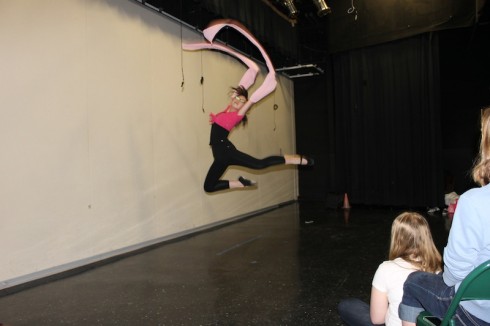
This interim focuses on our global community. As a result, one of our Chinese students gave a lesson on a traditional dance. I think I made a good start at learning the twirls, but we did not have time to get to the jumps.
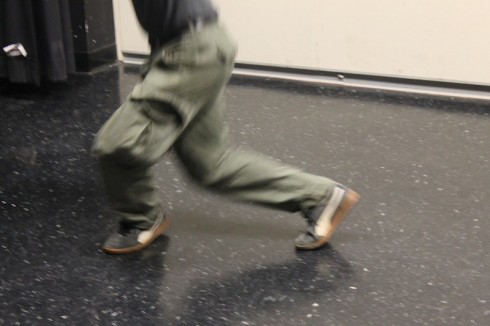
Middle and High School … from a Montessori Point of View

This interim focuses on our global community. As a result, one of our Chinese students gave a lesson on a traditional dance. I think I made a good start at learning the twirls, but we did not have time to get to the jumps.

Today we reconstituted our small groups for science. One student was late getting their name into the bowl so did not get randomly assigned to a group, so I deviated a little from our standard procedure and asked him which group he thought would be the best for him. Not which group he most wanted to be in, but which group he could be most effective — and learn the most — in. But, as a means of following up on all of our discussion at Heifer about what makes a community, before I gave him the chance to answer I asked the entire class to identify what qualities they thought they brought to their groups, and then, separately, I asked them what qualities the would like their teammates to have.
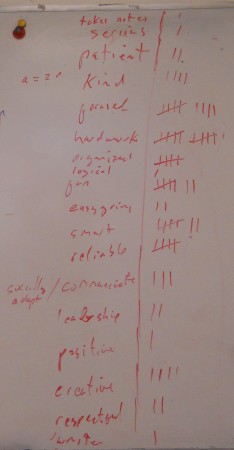
I got a number of interesting answers to the question about what they thought their qualities were. I know how hard it is to self-assess sometimes so I required that they could only put positive qualities, and allowed them to ask their peers for an external perspective.
My favorite response was from one girl who asked her friend sitting next to her what her positive qualities were, and the friend responded, “bossiness”. She thought about that for a second, then nodded and said, “that sounds about right.” When I asked them both why they thought “bossiness” was a positive quality they explained that the one girl was good at taking charge when necessary, and telling everyone what to do. I couldn’t argue with that description, because I’d observed it in their previous group work. The key part though was the “when necessary”, because while she does take charge, she’s very good at managing her group: giving everyone the opportunity for input while still being decisive. Instead of bossiness, I’d probably have used the term “leadership”.
After they had the time to compile their list of qualities they wanted to see in teammates, we compiled a list on the whiteboard (see Figure 1). Perhaps it’s just that they know what I want to hear, but it was quite nice to see that the top two characteristics were:
“Smart” and “fun” were the next most popular on the list, but after some discussion I/we decided to drop the “smart” since their criteria for smart was just having a basic level of intellectual competence, and it was somewhat less important than the other major qualities listed.
Of the remaining three major qualities that they’d like to see in teammates — focused, hardworking, and fun — I asked them each to pick the one they were going to focus on developing over the next month of group work. I asked a couple of the students who chose “fun” to reconsider since it was already one of their current areas of strength.
I then let them pick a second quality to work on from the full list, and had them write their two chosen qualities down somewhere prominent, because we’ll be checking in with them regularly over the course of the next month to see what specific things they’re doing to work on them, and how their efforts are going.
Then I let the student choose his group.
The discussion took the entire class period, and we did not get much “science” done, but if it can get students to be a bit more focused on their work it would be well worth the time.
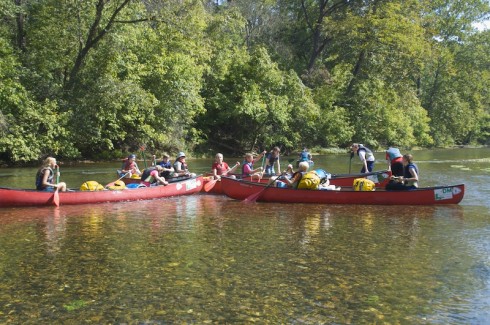
Observing my students figuring out how to canoe on the river this last outdoor education trip has reinforced my belief in the effectiveness of authentic team-building experiences over simulations and co-operative games.
Each morning, I assigned different pairs of students to each canoe. One of the main objectives of the outdoor ed trip is to help integrate the 7th and 8th graders, and the new 8th graders into a cohesive group. Good relationships among the students are necessary to achieve the benefits of the multi-age classroom.
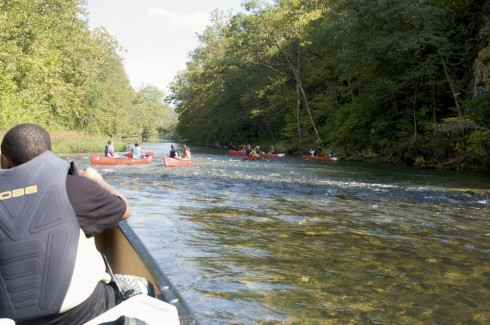
It took them a while (sometimes up to an hour on the water), but they eventually figured out how to work together.
And when one of the canoes tipped over — more from overconfidence than from anything else — everyone pitched in to help recover the canoe.

Then, when the storms came, they pulled together and all the practice paid off.

No simulation could have matched the experience.

From our Eminence Immersion.
ᔥ Curator’s Code ↬ On The Media
The Curator’s Code suggests symbols to help give credit for things on the web.
For example, I found out about the Curator’s Code on the On The Media program, so I should give them a hat tip like this:
I got the actual symbols off the Curator’s Code website so I could say the symbols come via them:
My standard form will be to stick these reference types at the bottom of each post or citation when they’re applicable. Like so:
Students in Lowell, Mass., are petitioning for the right to vote in their town. They argue that voting is an integral part of the civics they’re learning in high school, and they should be able to learn about, and vote on, issues in the communities where they grew up, and not have to wait until they’re in college.
Their campaign gained support of local politicians, cause the passage of a state law allowing the town to lower the voting age and even got a constitutional law professor (Lawrence Tribe) to write a letter supporting their case to the Massachusetts’ Secretary of State. They’re now organizing a ballot initiative for 2013.
Just as each species in a biological community contributes something that helps sustain the community, people need to contribute to each other in their communities to to keep them stable, productive, and happy.
We’ve been talking about social action this cycle. Students have been finding and reading articles, and thinking about what they could do — themselves right now — to promote social justice. The articles have come from a number of different places: local stories from the Memphis newspaper, the Commercial Appeal; national articles from the New York Times; and even international things from the from BBC. Now, for Personal World, they’re thinking at the really small scale, about what they do for their classroom community.
The objective is twofold. First, I want them to contribute more to each other, and think about what they’re contributing, to maintain a healthy community. A little self reflection should help them realize if what they think they’re doing for others is actually helping. But, secondly, I also want them to recognize the efforts of their peers for what they are: attempts, even if futile or misguided, to be helpful.
It’s sometimes easier to think about doing charitable things for people far away, because it’s impersonal. There’s little risk of being embarrassed. But even the smallest groups need some altruism to grease the wheels of community.
People are made of flesh and blood and a miracle fibre called courage.
— Mignon McLaughlin, The Neurotic’s Notebook, 1960 (quote via The Quote Garden.)
The character of an individual, and even of a people, is best identified in periods of adversity. That was one of the things that came up when my students discussed ethics, morality and poverty. With all the talk of how the Japanese people are reacting to last week’s earthquake, with a relative lack of looting and criminality, it is worth visiting Jesse Walker’s article in Reason last year that really looked at how people really respond to disasters. It turns out, that from Haiti to New Orleans to San Fransisco in 1906, people are much more restrained and disciplined than we’re lead to imagine.
Walker reviews Rebecca Solnit’s book “A Paradise Built in Hell: The Extraordinary Communities That Arise in Disaster” which points out the “little utopias” that arise in disaster hit communities.
Walker also points out the incongruity between our expectations and actual observations:
It isn’t unusual for a TV reporter to get his facts wrong. It’s rarer for the images that accompany his dispatch to flagrantly contradict what he says. But on January 21, broadcasting in the aftermath of the earthquake that devastated Haiti, CNN correspondent Ivan Watson fretted about “chaotic crowds” as the camera showed people who were calm and patient. When Watson announced that we were watching a “chaotic scramble” onto a rescue ship, this was illustrated by a group of refugees carefully, methodically passing a baby onto the boat.
–Walker (2010): Disaster Utopianism on Reason.com
There’s a curious and clear gender difference when it comes to my student’s use of their blogs. All the girls have them and most are posting things right now, but the boys don’t.
This is in large part due to the way I rolled out the student blogs. I started with a couple students (girls) who were most interested, and since then I’ve been setting up blogs for students as they’ve been requested. The process has been slow because I’ve been trying the multi-user version of WordPress (WPMU), which is not nearly as easy to set up as a stand-alone WordPress installation (like the one used for the Muddle). I think, however, that I have the setup process worked out now, so I could accelerate the rollout if necessary.
Since the two students I started with were girls, it’s perhaps not too surprising that it’s the other girls who were most interested in getting their own. That’s the way the social connections are arranged in our class.

Though there’s no real evidence for it, I do wonder, however, if there is a gender component to it too. Since girls tend to develop more quickly than boys at this age (see Sax, 2007 for a general description, and NIH, 2010 for a recent overview of adolescent brain development), so perhaps they’re more self-reflective. Girls also tend to emphasize interpersonal relationships more (e.g. Johnson, 2004), and are generally more communicative.
… females (1) develop more intimate friendships, (2) stress the importance of maintaining intimacy, and (3) expect more intimacy in their friendships than do males. — in Gender, grade, and relationship differences in emotional closeness within adolescent friendships by Johnson, (2004)
At any rate, I’m curious to see how this develops. I think I’m going to remind the whole class about the blogs though.
(Excel Spreadsheet used to create the brain volume scattergram: here.)